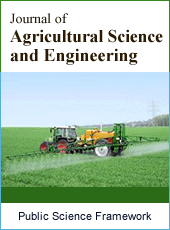Journal of Agricultural Science and Engineering
Articles Information
Journal of Agricultural Science and Engineering, Vol.1, No.3, Aug. 2015, Pub. Date: Jun. 30, 2015
Economic Analysis of Factors Affecting the Farmer Income Under Traditional Farming System in South Darfur State – Sudan
Pages: 114-119 Views: 5694 Downloads: 2424
[01]
Thabit Ahmed Hassan, Department of Agricultural Economics, Faculty of Agriculture, University of Zalingei, Zalingei, Central Darfur State, Sudan.
Agriculture is the viable leading sector and main vehicle for growth and development in the Sudanese economy and is certain to remain so far several decade's. The rainfed sub-sector is accounts for 85 to 90 percent of agriculture area in Sudan. Whereas; more than 75 percent of the population in South Darfur State, in western Sudan, are depending on agriculture as their main source of food and income. Millet is the main staple food cultivated in the northern and eastern parts of the region while sorghum is cultivated in the south and in the lowlands (wadi). Some people practiced other economic activities in the dry season. These activities are trade, government jobs, handicraft production and forestry related ventures. The sample was two stages stratified random sample representing the five localities of Nyala government. The farm household head age has got a coefficient of 4.586. This coefficient is significant at 1% level of significance. The value of farm assets had got a coefficient of 1.285, which is highly significant at 1% level of significance with the expected sign.
Darfur, Traditional, Farm Income, Lowlands, Significant, Value of Assets, Rainfed
[01]
Abdelrahman Khidir Osman (2007), Community based seed supply in Sudan2007 LEISA Magazine 23.2 June 2007,p18
[02]
Abdur Rashid M. Aranda da Silva (2000) FAO/WFP Crop and Food Supply Assessment Mission to Sudan.
[03]
Adedapo, Odulaja and Fassil, G. Kiros (1996). Modeling Agricultural Production of small-scale Farmers in Sub-Saharan Africa: A Case Study in Western Keneya. Journal of Agricultural Economic, vol. 14, No. 2 pp. 85-91.
[04]
Alemu Asfaw (2012), CTA, FAO-SIFSIA-N FAO-Sudan, Quasi Cropand Food Supplya Assessment Mission to Sudan, P 11-12
[05]
Eberhard H. and Klaus, P. (1999). Agriculture and poverty Reduction, the Benin Example, in Agriculture + Rural Development vol. 6 No. 2 pp. 57-60.
[06]
Elnoush, H. (1999). Micro-Finance and poverty Alleviation, the potential of Groups Lending: A Case Study of UNDP Project: Area Development Scheme Elobied Western Sudan.
[07]
Felix Sichali, Sherry McLean, Blessings Botha (2013), Seeds for change: a certified seed project in Malawi is boosting local incomes and supporting emerging national agricultural policy.
[08]
FAO and ICRISAT (2004). The World Sorghum and Millet Economics Facts, Trends and Outlook. FAO, Rome
[09]
Hassan, T.A. (1987). Economics of Millet Production under Subsistence Farming System in Darfur Region. A case Study of Central District Council of Southern Darfur Province. Unpublished M.Sc. Faculty of Agriculture, U. of K.
[10]
Joske, F.G. and Jacqueline, E.W.B. (1991). Appropriate Biotechnology in Small-scale Agriculture: How to Reorient Research and Development. P. 2, C.A.B. International Redwood Press Ltd. Melksham.
[11]
Simon, C. (1990). Report on Animal Traction Survey, Kebkabya Small-holder Project. ITDG Serise.
[12]
Swamy, P.A. and Mehta, J.S. (1979). Estimation of Common Coefficients in Two Regression Equations. In, Journal of Econometrics vol. 10 No. 1 pp. 1-14.
[13]
Tesfaye, T. (1993). Experimenting with a Cooperative – Based Credit approach in Western Sudan. Saving and Development vol XVII No. 3. IFPRI Washington DC. USA.
[14]
Thabit Ahmed Hassan, Elamin Ibrahim Hessein (2015). Economics of Resource Use in Millet Production under Subsistence Farming System of South Darfur State of the Sudan VOL. 5, NO. 1, January 2015 ARPN, P 27-31
[15]
WFP (2011). Comprehensive Food Security Assessment in Darfur UN World Food Programme, State Ministry of Agriculture and State Ministry of Health North Darfur.

ISSN Print: 2381-6821
ISSN Online: 2381-6848
Current Issue:
Vol. 7, Issue 4, December Submit a Manuscript Join Editorial Board Join Reviewer Team
ISSN Online: 2381-6848
Current Issue:
Vol. 7, Issue 4, December Submit a Manuscript Join Editorial Board Join Reviewer Team
| About This Journal |
| All Issues |
| Open Access |
| Indexing |
| Payment Information |
| Author Guidelines |
| Review Process |
| Publication Ethics |
| Editorial Board |
| Peer Reviewers |


